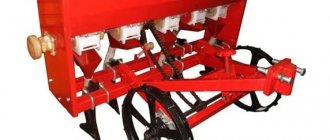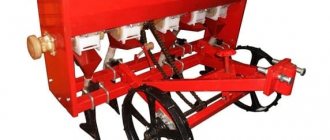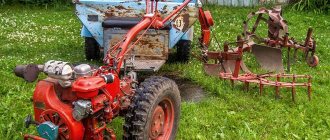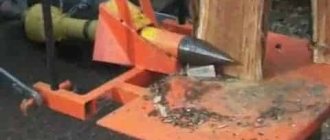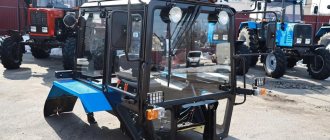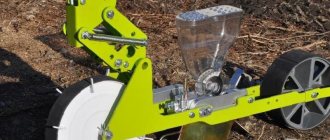- An important stage of work will be the location of the driver's seat. It must be positioned in such a way that the steering wheel does not rest on the driver’s knees, i.e. did not interfere with the free control of the device.
Homemade mini tractors have a very important advantage - they have very good maneuverability. Of course, this assembly method is a little more complicated than the alternatives, but it is definitely worth the effort.
A garden sprayer allows you to treat the most difficult to reach places, while the active product is securely held on the leaves. By clicking on the link, you will get acquainted with the different types of sprayers for the garden and vegetable garden.
Potato planters mechanize and improve the planting process, making the rows even, planting the tubers at the same distance from each other and at the same depth. Here you will find all the necessary information about potato planters.
In general, in this assembly method, a lot of components are taken from old domestic cars. For example, the steering rack can be borrowed from an old Zhiguli, the same can be said about the drum brake - it can also be taken from a used car.
Do-it-yourself 4×4 walk-behind tractor
Auto mechanic, specializes in agricultural equipment
Tillage is an integral part of the life of those people who have land at their disposal. Various tools are used specifically for this, but its use involves physical costs. To significantly facilitate the task, there is auxiliary special equipment. In this case we are talking about walk-behind tractors. Such equipment is quite expensive, which is why not everyone can buy it. Despite this, there is a possibility of making such equipment yourself.
How to make a 4x4 walk-behind tractor with your own hands
Many craftsmen can make such a device on their own if they have everything necessary for this. In this case, there is nothing significantly difficult; you only need to prepare certain devices, and also subsequently connect them into a single mechanism. Let's take a closer look at what is required to manufacture the device:
- First of all, you need to find an appropriate engine, since this is the main component of such equipment.
- Also, for the arrangement you will need to weld the frame; for this you can use ordinary metal sheets and pipes of small diameter.
- It is imperative to prepare the wheels (in this case, you will need 4 solid elements of equal radius).
- All other elements (drives, transmission mechanisms, suspension and transmission elements also need to be prepared or purchased if necessary).
- Separately, you should obtain a manual or electric starter from any similar equipment with an internal combustion engine.
- All work begins with equipping the frame; it must be made to fit the size of the engine, as well as 4 drive wheels.
- Afterwards, the suspension elements and the control handle, assembled from a metal pipe, are installed.
- At the next stage of creation, it is necessary to install the torque transmission elements, as well as the transmission.
- Next, the corresponding engine is mounted on top of everything, and the power plant is connected.
- Afterwards, you should install a fuel supply system and any container into which gasoline or diesel will be poured.
- At the very end, the starting elements (starter, spark plug, and power components, if necessary) are hung.
In this video you will learn how to make a 4x4 walk-behind tractor: After this, you need to install the wheels and perform a test run of the assembled device. It is worth noting that it is recommended to conduct trial tests at each stage of assembly to determine the functionality of the assembled device.
Important! At the initial stage of assembly, it is important to take care of equipping the walk-behind tractor with auxiliary equipment, as well as its connection (if necessary, plows, harrows, cutters and other components can be purchased or made independently).
What can it be made from?
When choosing material for tracks, it is important to consider that it should not be excessively heavy. Since the walk-behind tractor itself does not have a powerful engine, it simply cannot cope with heavy material and, most likely, will break. The caterpillar mechanism, as a rule, is made of tires, chains, pipes, belts, or a transport belt in combination with a bushing-roller chain.
Most craftsmen create tracks from tires - these parts are easily converted into the required design. It is necessary to choose tires for large trucks, taking into account the existing tread pattern and shape, because the correct pattern will improve traction. It is better if these are spare parts that previously belonged to tractors or other large models.
A properly selected tread will be able to have good contact with wet ground, ice-covered and snow-covered surfaces. In addition to materials for the tracks, to construct a full-fledged device you will need a walk-behind tractor with a gearbox, as well as a pair of additional wheels. If necessary, an additional cart is attached to the walk-behind tractor and, if desired, even on skids to transport loads in deep snow.
Reviews
It is worth understanding that when manufacturing a device with 4 drive wheels, it is necessary to install all drive axles, as well as the corresponding gearboxes for transmitting torque. All the necessary diagrams for arranging such equipment are freely available on the Internet. However, in this case it is necessary to pay attention to a number of comments regarding the use of homemade walk-behind tractors.
Oleg, 32 years old, Nizhny Novgorod
“At first glance, it seems difficult to assemble your own walk-behind tractor, but I managed to do it with minimal investment. The finished apparatus significantly speeded up soil cultivation. I believe that the manufacture of such a device is a worthwhile endeavor, since the need for physical costs is reduced to a minimum.”
Alexander, 46 years old, Saransk
“I am extremely pleased that I took the time to study the necessary schemes. The device was assembled quite quickly. I used all the old parts from the car, but had to buy the engine separately. The result was a good device, which required a small amount of time and material investments.”
On the Internet there are not only comments about the creation of devices, but also full-fledged discussions on thematic forums. Of course, some of the information there is superfluous, but there is an opportunity to create a reliable and interesting device as described.
Important! When making such equipment yourself, it is recommended to do everything in the established sequence in order to avoid mistakes and subsequently not have to completely redo everything.
Criterias of choice
- Pneumatic. Such products have a rubber tire and inner tube.
- Rubber. Monolithic design, which consists of a rim and durable rubber.
- Lugs. Metal elements aimed at increasing the cross-country ability of vehicles.
The difficulty of choice lies in determining the operating conditions of the equipment. For example, for processing clay areas or wet soil, it is recommended to use lugs.
A walk-behind tractor equipped with conventional rubber wheels will not show good performance in difficult conditions. In addition, you should focus on the wheel radius and tread pattern.
Wheel sets belong to the category of quick-change equipment, so it makes sense to purchase two types of chassis. For example, lugs and pneumatic wheels. This will allow the equipment to operate in different weather conditions.
What wheels can be put on a walk-behind tractor? Here a lot depends on the intended use of the technology. If the unit is needed for planting and harvesting work, you can choose pneumatic wheels.
Such products are optimal for working on soft ground. The recommended radius is about 40 centimeters. At the same time, we recommend choosing wheels with deep tread, which will increase maneuverability and cross-country ability.
For primary cultivation of virgin soil and soil with high volumes of stones, it is better to use cast wheels. They receive virtually no mechanical damage due to the absence of an internal chamber.
However, such elements have increased weight, so they are installed on medium and heavy walk-behind tractors.
The lugs not only increase the maneuverability of the equipment, but also increase its productivity. The teeth enter the soil, which creates additional force to move the unit in a given direction.
Such elements are used mainly for arable work on large areas of land. It is not advisable to use lugs on a small plot of land.
Walk-behind tractor: purpose
A walk-behind tractor is a mechanized piece of equipment for agricultural work. Depending on the engine type, it is powered by gasoline or diesel.
Compared to a tractor, the walk-behind tractor has small dimensions, which makes it convenient for cultivating small and medium-sized lands (0.1-1.0 hectares).
The nature of processing depends on the attachments of the walk-behind tractor:
- Plow – for plowing the soil;
- Garlic cutter – for sowing garlic;
- Potato digger - for collecting potato tubers;
- Aerator – for crop irrigation;
- Bucket – for removing snow and soil;
- Trailer – for transporting crops and other goods.
The corresponding attachments are included in all drawings of the walk-behind tractor, provided that they are presented by the same manufacturer.
Although there are exceptions - when the attachments fit all models. In any case, thanks to the attachments, the walk-behind tractor becomes a universal assistant on the farm and beyond.
Application area
Of course, they will differ in the power of the engine used, but the very specifics of the work they perform will be similar. In principle, the idea of assembling a home-made unit was to carry out the list of agricultural works characteristic of a mini tractor.
Probably its main purpose is direct work “in the field”. We are talking about plowing land holdings, removing weeds so that the treated soil is suitable for subsequent planting of potatoes and other vegetable and grain crops.
In addition, a homemade mini tractor can be used for the following purposes:
- transportation of various goods;
- cleaning up construction and household waste;
- cleaning local areas from snow masses;
- for cutting grass for the purpose of subsequent harvesting of hay for livestock.
Fortunately, there are plenty of all kinds of drawings on the Internet indicating the exact dimensions and parameters, which is quite enough for any rural craftsman.
But this does not mean that homemade mini tractors will be very inferior in performance to purchased options. If this is still the case, then this lag is not critical, and at the everyday level it is not noticeable at all.
What is needed to create a 4x4 walk-behind tractor.
Walk-behind tractor: device
The thematic unit is a wheeled chassis on which an engine with a power of up to 14 hp is placed. The motor is powered by diesel or gasoline to set the chassis speed through the gearbox.
As a result, the user of the walk-behind tractor effortlessly pushes the equipment forward, holding it by the handles. The latter houses the start and speed buttons.
The chassis of the walk-behind tractor consists of two wheel axles with thick tires. In winter, it is better to equip tires with chains so that the unit does not slip on snow and ice.
But for better maneuverability on wet ground, it is recommended to replace axles with tires with metal lugs.
An alternative option is a caterpillar track. But then the question arises: “how to make tracks on a walk-behind tractor with your own hands and what materials and means to use for this?”
To make themed caterpillars, enthusiasts use:
- Conveyor belt and links cut from a profile pipe;
- Split tires from cars and other transport equipment.
This explains the need to use a grinder for sawing metal and cutting tires. You will also need pneumatic tools for cutting in fasteners.
Mini tractor made from Agro walk-behind tractor
Before you start remaking walk-behind tractors of this brand, you should stock up on the material and necessary tools. To work you will need:
- stainless steel sheets and profiles;
- seat and steering wheel - can be removed from an old car;
- a pair of wheels – their diameter should not exceed 15 '';
- set of fastening elements;
- grinder and electric drill;
- hammer and welding machine.
After preparing everything you need, we advise you to study the diagrams, which will tell you the correct procedure for installing tractor elements.
The procedure for assembling the unit is as follows:
- At the first stage, you need to weld a strong frame for the tractor. To do this, use steel profiles and pipes. Be sure to keep in mind that the heavier the frame made, the better the grip of the minitractor with the ground. At the rear of the supporting structure, weld a towbar, which will be required to couple the trailer to the unit;
- Then proceed to manufacturing and arranging the chassis of the mini tractor. To do this, you can purchase a pair of ready-made front wheels, as well as hubs equipped with brakes. After purchasing the parts, attach the hubs to a steel pipe, and drill holes in the front of the frame that will be required to mount the hubs on the mini tractor. Next, install the tie rods using a worm gear. Following the rods, secure the steering column and rear axle. When installing the latter, press the bearings into the bushings used for installation. Install a pulley on the rear axle and securely fasten the wheels;
- After this, install the engine on the front of the frame. We recommend doing this using an additional frame placed on special shock absorbers - this will avoid strong vibrations under high loads on the engine;
- Next, install the driver’s seat on the mini-tractor, connecting it to the frame through springs - thanks to them, working with the mini-tractor will be much more convenient.
If desired, a compact tractor made by yourself can be equipped with a canopy that will protect you from rain and sun. To make it, 4 steel pipes need to be welded to the frame next to the seat and steering column, to which a steel sheet must be secured by spot welding. As a result, you will receive a reliable unit for your garden that will quickly cope with all the tasks assigned to it.
Walk-behind tractor: search for power plant
The simple design of the walk-behind tractor allows you to assemble it from scratch, borrowing various parts from donor units.
For example, the following have proven themselves well as a power plant:
- Chainsaw motor;
- Engine from small and medium-sized motorcycles - “Ant”, “Riga”, “IZH”, “Dnepr”;
- Engine from ZAZ, VAZ cars.
The first option produces power that is more akin to a cultivator, and not like a video on how to make a walk-behind tractor with your own hands, where a large unit sets the rhythm for equally large wheels.
Where is it used?
Initially, this type of equipment was created as an assistant for the farmer.
With a motorized cultivator you can plow the ground, transport loads, collect garbage, hay and leaves. However, the useful qualities do not end there. Based on it, you can create a snowmobile that will help those who live in the North. A good and properly modernized motor cultivator does not care about dirt or snow. Even in difficult areas, such equipment can accelerate to 75 km/h.
An all-terrain vehicle is especially useful in rural areas where there is no asphalt, but there are frequent showers and snowfalls. In this case, an all-terrain vehicle can become a real savior. At the same time, when the season comes, the all-terrain vehicle can be upgraded again into a regular walk-behind tractor, which will plow the land, clean the territory and perform a lot of other useful things, allowing the farmer to save time and effort.
Walk-behind tractor: search for other spare parts
Borrowing engines from passenger vehicles is convenient because the corresponding equipment may have the necessary gearbox and transmission. Then the enthusiast needs to adjust the wheeled chassis and frame to the “mechanics” and the power plant, and not vice versa, which is much more difficult.
To make wheels that will support a walk-behind tractor, you can use:
- Brake drums;
- Car wheels "Zhiguli".
Motoblocks on four wheels
Motoblocks have become an integral part of many rural residents, farmers and summer residents. Despite their efficiency in work and the speed of processing different types of soil, there is still one small drawback. Whether you like it or not, such a unit weighing on average 100 kg must be controlled by following it from behind. Yes, this is certainly easier than doing everything manually, but I want to make this work completely easier. Therefore, the owners of such units began to actively convert walk-behind tractors into mini-tractors, and manufacturers soon got involved and began producing advanced diesel walk-behind tractors not with 2, but with 4 wheels.
Now we will get acquainted with these units in more detail and tell you about all their advantages and disadvantages.
Description of walk-behind tractors with 4 wheels
This unit is a kind of mini-tractor, which is created on the basis of a walk-behind tractor. Some people prefer to make them with their own hands, some buy factory kits for making them, and others buy a ready-made factory product. It doesn’t matter which way you choose to purchase such equipment, all the advantages will be obvious for absolutely all models:
- convenient, easy control of the unit using a conventional steering wheel;
- built-in seat for the driver, which makes the work of the owner of such equipment much easier and now you don’t have to walk behind him;
- Thanks to the hydraulic linkage drive, lowering and raising the attachment is easy using a lever;
- performing work with such a walk-behind tractor will be even more efficient and of high quality;
- with its help you can not only perform different types of work, but also transport goods.
Let's use the example of the Bison JR-Q12 to look at the technical characteristics of such walk-behind tractors:
- Engine: single-cylinder 4-stroke SH 195NL with direct injection
- Power: 12 hp
- Fuel tank: 5.5 l
- Cooling: water
- Starter: manual
- Clutch: disc
- Number of gears: 6/2 forward/reverse
- Dimensions: 214/90/117 cm
- Weight: 260 kg
In principle, with a factory walk-behind tractor with 4 wheels, everything is clear: you are purchasing ready-made equipment that will perform well on any soil, both in small and large areas. Now let's look at the option when purchasing a kit for converting a walk-behind tractor into a mini-tractor.
Now many manufacturers offer to purchase a set of spare parts for self-conversion of the unit. In addition to the necessary parts, they include instructions on how everything needs to be assembled. In principle, this option is quite good; you receive ready-made spare parts that need to be assembled according to the instructions in the instructions. This kit is affordable and easy to assemble, which is its advantage.
Increased speed and maneuverability
These questions are relevant for those who have to work on heavy and damp ground, on ups and downs. Even the most advanced models can slip, forcing the operator to exert additional effort to push the machine forward. Many people are not satisfied with the speed of the unit when towing equipment or transporting various loads.
There are several ways to solve these problems:
- Increase wheel diameter. Most walk-behind tractors are equipped with wheels with a diameter of 25-30 cm. If you install 45-50 cm wheels from an old small car, the speed of the unit will double. But you should not make a racing car out of a walk-behind tractor, since this device is not highly durable and has good stability. You can accelerate to 25-30 km/h only on a flat road without sharp turns.
- Manufacture and install weighting materials. For such factory-made devices in the store you will have to pay a large sum. It is better to make them yourself from scrap materials. Weights are placed on the wheels and on the frame. The wheel weight is made of steel wheels and a hexagonal solid profile. The welded parts are inserted into the hubs with a hexagon and secured with cotter pins in the drilled holes. Instead of iron disks, you can use reinforced concrete blanks or flat round flasks with a neck, into which sand is poured. The body of the walk-behind tractor is weighted using removable frames from the corner. Loads of various weights and configurations are already screwed to the frame.
- Secure the tracks. This solution will allow you to turn the walk-behind tractor into a full-fledged low-speed snowmobile. It is enough to install another axle with wheels and purchase wide rubber tracks. Stoppers need to be attached inside the tracks to prevent them from jumping off the wheels. A homemade snowmobile can also be useful in the spring, when the soil is wet and the terrain is impassable for conventional equipment. As a kit for a homemade snowmobile, you can make a sled for transporting various property through the snow, going hunting, fishing, or to the nearest store after a snowfall.
Homemade four-wheeled walk-behind tractor
In order to save money, many convert an ordinary walk-behind tractor into a mini-tractor using improvised means. But in this case, you cannot do without a technical mindset, attentiveness and intelligence. You need to be good at what you are doing. Stages of creating a diesel walk-behind tractor into a mini-tractor on 4 wheels
- We create a frame in the shape of a trapezoid by welding a rolled channel. Next, we make holes in it for other mechanisms.
- We weld the corners to the frame. They will serve as a rack and stretcher. We connect them at the top.
- We mount the rear axle on the frame. If an all-wheel drive unit is created, the front axle will also need to be mounted.
- We mount the engine.
- We install the gearbox. It must be directed towards the driver. This will make operating the walk-behind tractor convenient, simple and comfortable.
- We mount the steering.
- We weld the towbar.
- We install the tank, electrical system and brake system.
With these steps, you can create your own four-wheeled walk-behind tractor from available materials. With such equipment, your work on the site will be much more comfortable and easier.
Instructions for building a walk-behind tractor
Making a walk-behind tractor frame
It must be welded, but the strength must be preserved, since other parts will be adjacent to it. Unnecessary iron and alloy pipes will come in handy. You will need a diagram again. From the previous design you will need to remove the front fork, as well as other elements that may somehow interfere.
A mechanism for coupling with other equipment is attached to the back. If it’s not entirely clear, a video or tutorial will help you figure it out.
Walk-behind tractor engine
What is suitable as an engine has already been said earlier, but to make the unit more useful, the engine power may not be enough. Then purchase or find a diesel motorcycle engine.
First rebuild the cooling system. This can easily be done using a 12-volt motor. Simultaneously with these processes, the valve is slowly changed. The result is improved performance. When the engine is ready, it is firmly mounted.
It is important to ensure that it does not dangle or fall out when moving. Attach the lever
It could be a twig. The length of the handle is chosen independently, the main thing is that it is comfortable for the owner.
You will also need a part that will protect against pungent odor. It’s quite easy to make from available materials. An iron coffee can, for example, will do. Any container that does not allow liquid to pass through will serve as a fuel tank.
Walk-behind tractor transmission
For a homemade machine you will need chains, sprockets and an adapter shaft. They can be found in equipment that has already become obsolete. Sprocket hubs are easy to make without any specific knowledge, just imagine what it should look like and have enough iron. The gearbox will require iron plates, as well as cylindrical disks with teeth.
The instructions and action plan should be very simple so that the system of operation of the mechanisms is understandable. It is necessary to install a regular roller chain with sprockets
It is important that the operating principle is clear. If not, watch the explanatory video.
Thanks to the installation of this device, the controllability of the unit is improved. You can make a creeper yourself, but it’s easier to buy one.
Walk-behind tractor chassis
It is better to choose pneumatic wheels whose diameter is no more than 10 inches. Suitable for passenger cars. If you need to work on frosty soils, you can replace conventional wheels with iron ones. On a homemade cultivator, instead of wheels, you can install a rotary cutter so that you can dig up the soil.
Control device
The head of the machine is a man. Without him she is useless. This is what the handles are for. You can make them yourself from two thick iron pipes. For convenience, give them a shape that is convenient for you.
Gas handles and clutches are installed at the ends. There shouldn't be any problems with the gearbox. Levers are best made from a metal rod. It is necessary to secure the brake levers, as well as the gear selector.
A steering adapter will also work. In such a mechanism, the bipod is a coupling. You can use a ball joint, which will make it possible to strengthen the hitch and make it independent. Refer to the video again if anything is not clear.
Until we started designing
Before making a homemade all-terrain vehicle from a walk-behind tractor, from an old vehicle, the details are clarified. You can make an all-terrain vehicle based on a walk-behind tractor with caterpillar tracks or pneumatic wheels. The tracked unit is not difficult to operate - this is important to take into account. You need to understand where and under what conditions you will use the device, as well as how many people and what weight the vehicle can carry without damage. Next you can develop:
- sketch;
- blueprints.
It is difficult to find a gasoline tool that can compare with a chainsaw in terms of the number of homemade products. Winches, boat…
However, it is prohibited to take any car engine. The engine must have forced cooling. It is necessary to buy devices with air and water cooling.
When using a homemade all-terrain vehicle walk-behind tractor in winter, it is better to use a 4-stroke engine. It is the one that works excellently at low temperatures, it is mobile, and easy to operate. A small 4x4 all-terrain vehicle with a walk-behind tractor engine, made independently, will become a true pride for any craftsman. The units can be purchased at a low cost, so it is easier and more economical to assemble them yourself.
Recommendations for use
When using walk-behind tractor tracks, you must constantly check how well the chain is tensioned, and also regularly oil the parts whose friction occurs during movement. In addition, it is recommended to check each time before use whether any damage or breaks have appeared on the circuit. After the trip, you should also conduct a routine inspection in order to detect any damage or failed hooks in time. When using a walk-behind tractor, you should avoid hitting roots and rocks, as well as stumps, otherwise the tracked module will very quickly be torn.
For a review of the all-terrain walk-behind tractor on tracks, see the following video.
Which engine to use
It is problematic to give a concrete answer to this question. Any engine (both gasoline and diesel) has advantages and disadvantages. Gasoline is expensive, and diesel fuel freezes quickly in subzero temperatures. All-terrain vehicles made independently are very relevant due to the fact that they produce many Chinese units with powerful and high-quality engines that can be ordered relatively inexpensively. This makes it possible to purchase a simple car, and then upgrade it according to your individual wishes. The engines are considered easy to maintain and can be used as spare parts at any time. In order to make the chassis, pros recommend using a unique independent wheel suspension in the design. Despite the fact that it is simple in design, the builder receives a device that is simple and comfortable to use.
When there is no independent suspension, you can:
- use simple pneumatic wheels (from two to four);
- make a unit from walk-behind tractors on low-pressure tires.
It is allowed to use two types of frame: flat or spatial. In a situation where a vehicle is designed:
- on tracks - it is solid;
- on wheels - articulated.
To assemble a mini-tractor from a walk-behind tractor with your own hands without making mistakes, you will need step-by-step instructions and...
The second system can also be used for tracked vehicles. You can watch the video.
Ready walk-behind tractor: prospects for modernization
Each detailed instruction on how to make a walk-behind tractor with your own hands suggests the idea of upgrading the thematic unit until you obtain the following equipment:
- Mini tractor;
- Snowmobile;
- Truck.
When designing the listed transport and agricultural vehicles, it remains to calculate the engine power so that it can cultivate large areas of land or withstand the body of the same truck.
Pneumatic vehicle and swamp vehicle
A swamp vehicle is a highly cross-country vehicle. The unit showed itself excellently in marshy areas, shallow waters, muddy areas and swamps. Such transport is relevant for those who often go outside the city, tourists who overcome hundreds of kilometers of difficult off-road conditions. The construction of homemade swamp vehicles is the same as in the manufacture of an ATV or caracat. A pneumatic vehicle is a type of car developed in the 50s. last century.
Conventionally, such a transport can be called a walk-behind tractor on pneumatic wheels. It is clear that the main difference between a pneumatic drive and other home-made walk-behind models is the wheel base. Due to the low effort on the road, low-pressure tires make it possible to avoid overloading, slipping, and troubles.
Step by step instructions
A carat made from a walk-behind tractor is a rational investment of effort and finances. An all-terrain vehicle from a walk-behind tractor is created according to the scheme. Construct the base. It will be possible to take ready-made frames. For example, remove Ural or Izh from used cars. They are durable and easy to maneuver. The rear axle includes both suspensions, which are made from: strut, mowing, bushing. For all-terrain vehicle wheelbase. It is allowed to use a used spare tire from a truck. Transport on the SND is easy to drive and maneuverable. A prefabricated engine structure is mounted so that the all-terrain vehicle performs the necessary functionality. If the motor installation is completed, install:
- transmission;
- exhaust parts;
- braking structure.
Parts from old vehicles will do. The ATV has good maneuverability, maneuverability, and safety. It looks like a 4-wheeled motorcycle vehicle. Typically, an ATV is built on a walk-behind tractor from a Neva car. The step-by-step instructions are as follows:
- Wheel conversion. The wheels are positioned at an equal distance from the car body using adapters.
- The frame is being modernized and strengthened. It is correct to use a ready-made base from motor vehicles; it is reliable and will not cause problems.
- Installing car wheels. You can use a low profile. You can reduce friction between tires and rims using fabric spacers.
- Tires are mounted. Truck wheels are suitable. You can take tires with low pressure. There is no need to install shock-absorbing elements.
After simple manipulations, the created ATV from a walk-behind tractor is used off-road. In addition to transport, you can do SND.
A walk-behind tractor on pneumatic wheels creates minimal impact on the road. On the rear axle, homemade tires are used, which can be installed on:
- Swamp walker.
- Motor sleigh (air sled).
- Snowmobile.
- Motoblock towing vehicle.
You can buy store-bought items or purchase parts separately (tires, tubes, wheels). The assembly diagram is as follows:
- Standard disks and fasteners are welded with metal tubes.
- They make larger cameras with more secure mounting.
- Tires are attached to the finished expanded disk. You can buy it or use it used from a truck. An air valve is inserted into the hole in the disk.
- The wheel is filled with a pump. The created tires are mounted on an all-terrain vehicle from a walk-behind tractor.
To increase the power of a standard wheel, it is equipped with a tread. Chains and tracks made in a workshop are suitable for mounting cameras.
More popular homemade models with a motor from a walk-behind tractor were described. However, the ingenuity of the craftsmen from the people in relation to such a unit does not end there. Residents of the north have long appreciated the advantages of snowmobiles, motorized sleds, and snowmobiles. A mini tractor or towing vehicle with a walk-behind engine is actively used by farmers.
Algorithm for self-production of twin wheels
To improve the cross-country ability of a country motor-cultivator, the factory wheels are replaced with homemade twin structures made from rims from passenger cars. High-quality elements will last at least 10 years with intensive use of the unit.
To work, you will need sheet steel with a thickness of at least 10 mm, wheels from a car (Zhiguli, Gazelle, Moskvich) of a suitable radius, tires, bolts 40-50 mm long, washers with a hole diameter of 8 mm, nuts, a marker for marking, a tape measure, a jigsaw, grinder, wrenches, vice, drill, metal drill, welding machine.
Follow the step-by-step algorithm:
- make templates made according to the drawings from plywood or durable cardboard;
- using template elements, make a fold in a metal sheet of steel;
- make a bolt pattern of 10 in 4 places;
- drill holes to secure the weights;
- weld the workpiece to the car rim;
- clean the edges of the discs from irregularities, nicks, and rubber tire residues;
- Weld weights onto the inner surfaces of the rims;
- weld the car blanks along the edges to make a three-dimensional wheel;
- equip the homemade part with rubber of a suitable diameter.
Make preliminary calculations and drawings, where you mark the location of the fasteners and the dimensions of the holes.
To improve the maneuverability of small-sized farm equipment and improve the quality of work, you can make homemade wheels for a walk-behind tractor. The shortcomings of the factory equipment are corrected by installing weights on the rims, replacing tires with a pronounced textured pattern or studs, and installing automobile wheel structures.
